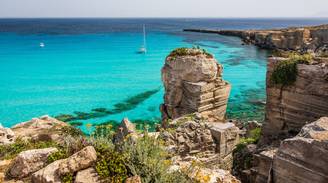Favignana Ferries
Book your next trip!
Find and book ferry tickets to and from Favignana
Find and book ferry tickets to and from Favignana

Favignana boasts 8 ferry routes operated by 2 top-tier ferry companies. Get ready for a convenient sailing experience from Favignana, with schedules perfectly tailored to the seasons, ensuring you always find your ideal departure.
Favignana offers connections to popular routes like Trapani - Favignana, Marettimo - Favignana, Levanzo - Favignana. You can customise your trip by choosing between a swift high-speed ferry to get there in a flash or a classic vessel for a more scenic, relaxing journey. From quick local hops to leisurely overnight voyages, your adventure starts here.
Getting to your destination is a breeze with several excellent ferry operators departing regularly from Favignana. You'll find companies like Liberty Lines, Siremar ready to whisk you away.
Each offers a variety of onboard amenities to make your journey pleasant, from comfortable seating and delicious food and drink options to private cabins and even vehicle transport.
With a range of ticket options available depending on the company and vessel, there's something to suit everyone, whether you're traveling solo, with family, or on a business trip.
Whether you're dreaming of an escape, making your way back to the comfort of home, or embarking on a brand-new journey, your perfect voyage begins right here with Favignana.
Route Overview
Route Overview
Operators
Routes
Date Updated: 2025
Reaching Favignana's Shores
Reaching Favignana's Shores
Favignana is accessible primarily by ferry services operating from Trapani and Marsala on Sicily's mainland, with crossings taking approximately 20-30 minutes from Trapani or 50 minutes from Marsala. Travelers typically reach Trapani via bus or car from Palermo (about 1.5 hours) or Catania (3 hours), with Palermo's international airport being the most convenient air hub. Regular buses connect Trapani's central station to the ferry terminal, making transitions smooth for foot passengers. If arriving by car, several parking facilities are available near the Trapani port, though leaving vehicles on the mainland is recommended as Favignana is best explored by bicycle or scooter.
Popular Routes
Popular Routes
Favignana: The Butterfly of the Mediterranean
Favignana: The Butterfly of the Mediterranean
Nestled in the crystalline waters of the Aegadian Islands, Favignana combines rugged coastal beauty with authentic Italian charm. This butterfly-shaped island off Sicily's western coast boasts turquoise coves, historic tuff quarries, and a relaxed pace that epitomizes Mediterranean island life. As a key ferry destination in the Tyrrhenian Sea, Favignana offers visitors a perfect blend of natural wonders, rich maritime heritage, and the simple pleasures of Italian island culture.
Seasonal Rhythms of Favignana
Seasonal Rhythms of Favignana
Favignana enjoys a classic Mediterranean climate with hot, dry summers and mild, occasionally rainy winters. The ideal visiting window falls between May and June or September and early October when temperatures hover pleasantly around 22-28°C (72-82°F) and the tourist crowds thin out considerably. July and August bring peak temperatures, abundant sunshine, and the island's busiest period when ferry services increase to accommodate summer visitors. Spring offers wildflower displays across the island's interior, while autumn provides warm sea temperatures perfect for swimming. Winter months (November-March) see reduced ferry schedules and some seasonal businesses close, though the island maintains its authentic character for those seeking tranquility.
Ferries to and from Favignana
Ferries to and from Favignana
Island Connections from Favignana
Island Connections from Favignana
Favignana serves as an excellent base for exploring the entire Aegadian archipelago by ferry. Levanzo, just a 20-minute ferry ride away, charms visitors with its whitewashed houses and prehistoric cave paintings at Grotta del Genovese. The more distant Marettimo (about 45 minutes by ferry) offers untouched nature, excellent hiking trails, and some of the clearest waters in the Mediterranean. Regular connections back to Sicily make day trips to Trapani's medieval center or the salt pans of Marsala easily manageable. The ferry routes themselves provide stunning views of the archipelago's coastlines and the changing colors of the Tyrrhenian Sea, especially during sunrise or sunset crossings.
Island Treasures and Coastal Pleasures
Island Treasures and Coastal Pleasures
Favignana's azure waters beckon exploration of its famous coves, with Cala Rossa and Cala Azzurra offering spectacular swimming and snorkeling among rock formations carved from ancient tuff quarries. The island's maritime heritage comes alive at the former Florio tuna processing plant, now an engaging museum documenting the traditional 'mattanza' tuna harvest. Cycling the flat island terrain provides access to hidden beaches and panoramic viewpoints, with rental shops clustered near the port. Culinary adventures await at waterfront trattorias serving local specialties like pasta with tuna bottarga, fresh sea urchins, and cassatelle sweet pastries. The central piazza in Favignana Town buzzes with authentic island life, particularly during the evening passeggiata when locals and visitors alike gather to enjoy the Mediterranean ambiance.
Fascinating Tales from the Butterfly Isle
Fascinating Tales from the Butterfly Isle
Favignana's distinctive butterfly shape inspired its ancient Greek name 'Aegusa,' meaning 'goat island,' due to the two wing-like peninsulas resembling goat horns. The island's economy was transformed in the 19th century by the Florio family, who revolutionized tuna processing and created one of the Mediterranean's most advanced industrial complexes of its time. Favignana's unique tuff stone, extracted from quarries that now form stunning swimming coves, was once exported throughout Sicily and beyond for construction. The island holds a curious world record for the most tonnara (traditional tuna traps) in a limited area, with historic underwater nets strategically placed around its coastline to catch the 'passing of the tuna' during seasonal migrations.
FAQs
FAQs








